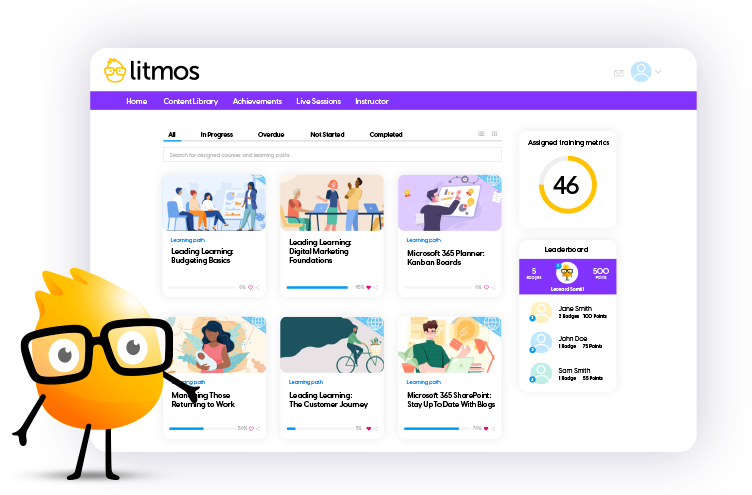Choosing a Training Management System
For organizations looking to develop smart, scalable training programs, eLearning has been absolutely transformational. Beyond dramatically reducing the costs associated with traditional face-to-face training, it also gives both training staff and learners increased flexibility.
It has also enabled training staff to spend less time managing the administration and logistics of training, empowering them to do more with their time and talent throughout the day.
The end result is the ability to create training programs that are more engaging and effective, dramatically boosting the value of company investments in learning.
Training vs. learning: what’s the difference?
While all training is learning, not all learning is training. The difference lies in the objectives. While learning can occur for the sake of simply acquiring knowledge, training connects learning objectives to overall business goals:
- Onboarding new employees
- Upskilling teams
- Introducing new products or services
- Equipping users with ‘soft skills’
- Satisfying new compliance rules and requirements
- Measuring job knowledge/performance
These outcomes mean training teams have to think like both educators and business strategists. They need to find the most innovative and effective ways to create content that supports diverse, ever-evolving business needs. That’s where learning management systems (LMS) become something even more critical, a training management platform.
What can a training management system do?
A training management system provides a single platform where business objectives can be met through user learning. It centralizes both the administrative and educational requirements, giving trainers and other stakeholders one place to:
- Create and deliver content
- Integrate elements to support different learning strengths and modalities
- Add and manage users
- Schedule learning events
- Customize learning plans per team or user
- Track user progress and performance
- Update content based on new internal/external business needs
- Report on all of the above (and more)
A modern eLearning system can also give employees the freedom to complete coursework on a more flexible schedule. They may not even need a company resource to do it. An advanced LMS (like Litmos) can deliver content 24/7 to a wide range of devices, even employee smart phones. This reduces the barrier to completion and increases completion and retention rates.
The difference between a training management system and LMS
Each organization has its own unique overall business and learning objectives. These are best achieved by specific supporting learning objectives at the unit, department, team, or individual level. This means a single learning management platform must be able to meet diverse learning needs with a consistent set of authoring tools, delivery mechanisms, and end-user interfaces. This ensures lower costs through consolidation and a better, more consistent learning experience.
Choosing an LMS to support your training needs starts with understanding key purchasing decisions. These decisions will all impact how the LMS is implemented, maintained, and scaled.
Open Source vs. Proprietary
When authoring and delivering learning and training, businesses can choose either an open source or proprietary LMS.
Open Source systems essentially require teams to start from scratch. It also makes them responsible for all of the technical work required to produce and deliver the coursework. They are best suited for organizations that have large software and content development teams with the expertise to complete the work. They offer unlimited customization and flexibility, if you have the talent to implement it.
Proprietary systems give teams a pre-packaged set of tools for content creation. Depending on the solution, businesses will also have to buy additional software to deliver the content and track student progress. These tools have been refined over time so that trainers and human resources teams, even those without advanced training, can often get the work done. While the flexibility is immense and growing, you will inevitably need to make choices and trade-offs to reach content goals.
Self- vs. vendor-hosted
As with any many major enterprise software packages, businesses can choose between the option of hosting the LMS on-site or letting a vendor manage access and availability
Self-hosted systems stay completely in the control of your organization’s IT department. They get to make performance, security, and access questions. They’re also able to manage and maintain the system, including updates, according to IT policy.
A vendor-hosted solution leverages the power of the cloud to reduce, and sometimes completely eliminate, the burden on IT. They manage configuration, hosting, security, and performance tuning. The organization can upload users, add new content and curricula, and generate reporting and analytics. And, if they do run into trouble, there’s a dedicated support staff ready to assist.
Understanding and comparing costs
Calculating the total cost of ownership and operations between the different versions depends a lot on specifics. While the high initial cost of a proprietary, vendor-hosted solution might seem high, it must be compared with the overall long-term costs of not only implementation, but ongoing maintenance and scalability. This is why the decision is best made as a cross-functional team, with HR, training, and IT working together to evaluate options.
Beyond the set up and maintenance costs, each LMS option offers different pricing models for the delivery of learning. This gives businesses the ability to select a pricing structure that makes the most effective use of training dollars. Litmos in particular has worked hard to offer diverse ways to pay for the training you need to meet your business objectives while aligning to finance requirements. These options include:
- Localized training pricing
- Multiple prices for the same course based on role
- Automatic price selection based on student criteria
- Course and schedule-specific pricing
- Pricing in different currencies
- Pricing valid for specific date ranges, such as early bird
- Group pricing vs. individual pricing
- Bundle pricing
- Session-based pricing
No matter how your business manages training cost, the Litmos Training Ops team can craft a pricing strategy to match. Ultimately, our aim is to make sure your people get the training your business needs.
Revenue Recognition
These diverse pricing models also enable stronger revenue recognition from training events and activities. This is an essential step, especially in large organizations, to understanding and demonstrating the value of training investments. Litmos Training Ops was designed with a dedicated revenue recognition feature set that give stakeholders better visibility and control. You receive the following:
- Revenue settings that provide a flexible infrastructure for defining rules that can include course criteria, reference dates and cut-off dates
- Automatically updated registration records based on parameters created by your organization
- Revenue management with the “Revenue Recognition” tab to stream the transfer registration revenue data directly from Litmos Training Ops to any department
- Application options of frequency when applying amortization to your revenue recognition
- Date setting features such as invoice, purchase or invoice date to determine how revenue will be recognized.
Explore Litmos For Free
Your choice of a training management platform will impact your business for years. To learn more about Litmos LMS, the trusted training platform of global business leaders like Coke, ask about a free 14-day trial. Or, ask for a free in-depth demo.

Learn more:
What is a learning management system?


